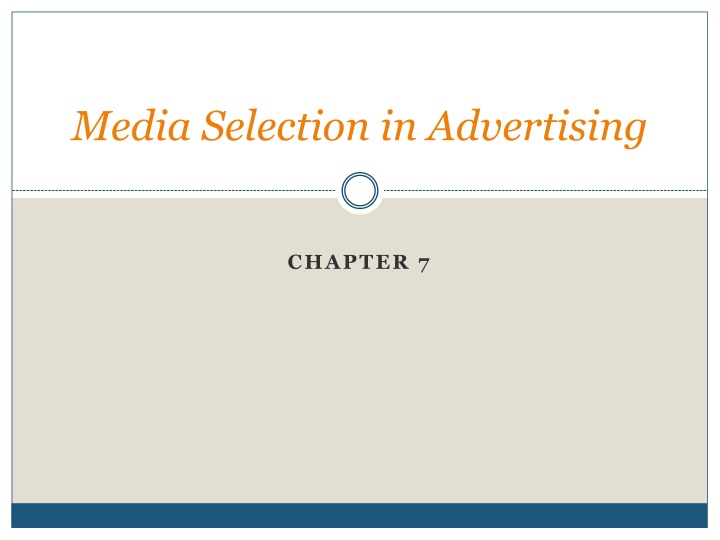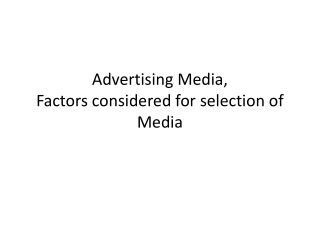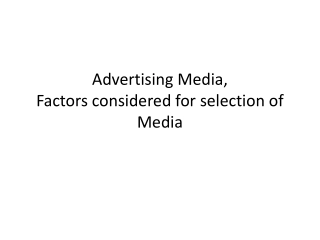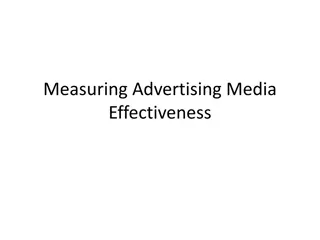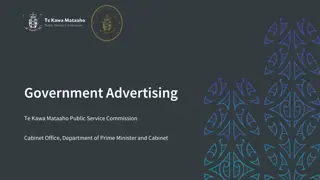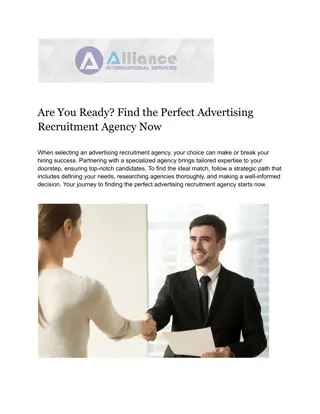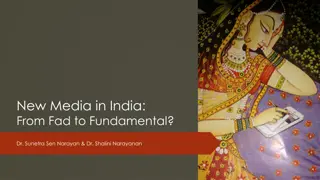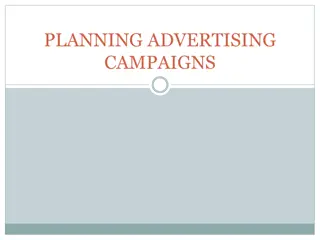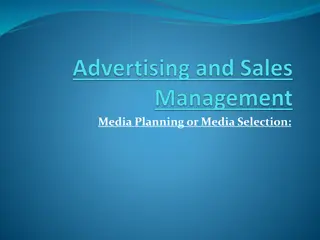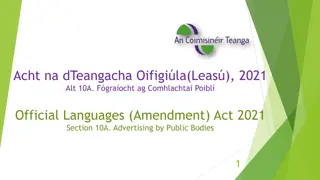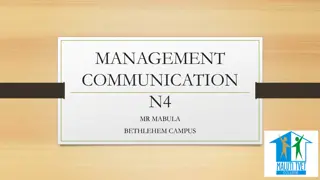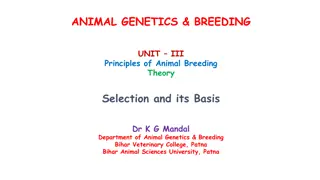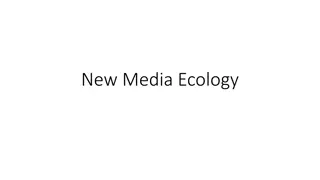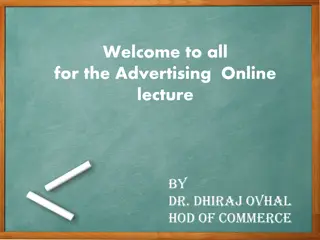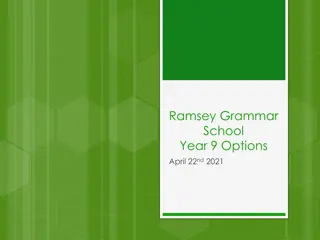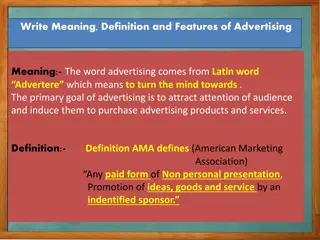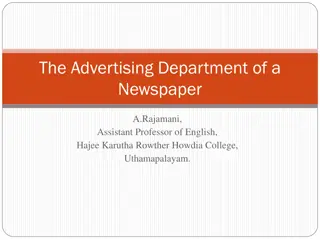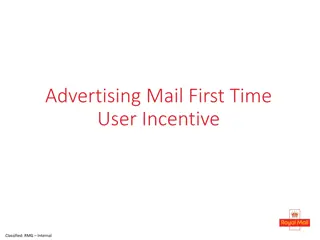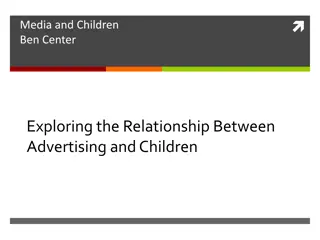Media Selection in Advertising - Factors and Impact
Various factors influencing media selection in advertising, including organizational objectives, target markets, costs, message themes, constraints, and product considerations. Learn how these factors shape the marketing communications mix and impact consumer behavior. Discover unique and effective advertising strategies across traditional and unconventional media platforms.
Download Presentation

Please find below an Image/Link to download the presentation.
The content on the website is provided AS IS for your information and personal use only. It may not be sold, licensed, or shared on other websites without obtaining consent from the author.If you encounter any issues during the download, it is possible that the publisher has removed the file from their server.
You are allowed to download the files provided on this website for personal or commercial use, subject to the condition that they are used lawfully. All files are the property of their respective owners.
The content on the website is provided AS IS for your information and personal use only. It may not be sold, licensed, or shared on other websites without obtaining consent from the author.
E N D
Presentation Transcript
Media Selection in Advertising CHAPTER 7
Whats Happening? http://www.youtube.com/watch?v=57e4t-fhXDs News Story: http://www.ctvnews.ca/mobile/canada/say-goodbye-to-the-timbit- dutchie-tim-hortons-getting-rid-of-24-menu-items-1.1696571 https://www.youtube.com/watch?v=o4wNMOapzyw
What kinds of ads get your attention? Are they found in traditional media like television or unusual places? Where is the most unique or oddest place that you have seen an ad?
Attention getting ad? Why or why not? This ad was above a urinal.
Media Planning Focus on consumer behaviour Create plans that reflect the purchase process (Chapter 3) Positively influence consumer in the marketplace Study media choices Listening and viewing habits
Media Planning 8-6 An advertisement by New Balance placed in Runner s World magazine by the media planner.
Factors that have changed the role of Media IMC more than just mass advertising now Cost factors Technology Globalization Complexity of the media function Profitability
Media Selection Factors Reasons as to why certain media are selected: Organizational Objectives Target market(s) Costs Message Theme Constraints Product/Service considerations
Media Selection Media selection factors influence our marketing communications mix. Marketing communications mix the combination of tools used to promote a product or service. Could include, but not limited to, advertising media (many forms), sales promotions, public relations and digital and social media.
Selecting Media o Television o Radio o Transit o Billboard o Outdoor /Out-of-Home o Internet o Magazines o Newspapers o Direct Mail o Alternate media
F I G U R E 8 . 5 Developing Logical Combinations of Media - Table 7.12
Whats Happening https://www.youtube.com/watch?v=jIfV2OYpyJo
Achieving Advertising Objectives 1. Three-exposure hypothesis Intrusion value Takes a minimum of three exposures for an ad to be effective Effective frequency number of times that one must be exposed to message to achieve its objective Effective reach - % of target market that must be exposed to ad to achieve its objective Size, placement, length of ad are factors to consider Number of media used is important (variability)
Achieving Advertising Objectives 2. Recency theory One exposure may be enough Effective the closer to a purchase States that consumers use selective retention when they consider ads. Advertising is a waste of money when intended market is not reached
Achieving Advertising Objectives o Media Multiplier Effect o The combined impact of using two or more media is stronger than using either medium alone o Often the reason for using several different media o This ensures a broader effective reach
Ad Campaign Continuity Continuous campaign Advantages: Serves as a constant reminder to the customer Covers the entire buying cycle Disadvantages: Higher costs Potential for overexposure
Flighting Campaign Advantages: Cost efficiency of advertising, only used during purchase cycles Allows for more than one medium or vehicle on limited budgets Disadvantages: Lack of awareness, interest, retention or promotional message during non-scheduled times could lead to decay
Pulsating Campaign Advantages: Same as the two previous methods Disadvantage: Not required for seasonal products, or other cyclical products, therefore adding to organization s expenses
Advertising Terminology Reach Number in target audience exposed Typically 4-week period Frequency Average number of exposures within a given period Opportunities to see (OTS) Cumulative exposures Placements x frequency Ratings and Cost per Rating Point (CPRP) Ratings measure percent of target market exposed by medium CPRP allows for comparison across media Cost of media buy / vehicle s rating Weighted CPM
Advertising Terminology Costs Cost per thousand (CPM) CPM allows for cost comparisons Gross rating points (GRPs) Measures impact of intensity of media plan Vehicle rating x OTS (number of insertions) Impressions Gross impressions total audience exposed to ad Continuity Continuous campaign Pulsating campaign Flighting (or discontinuous) campaign
Table 7.3 plus Cost for 4- color full page ad Total readership (000's) CPM Total Target Market (20M) Magazine Rating (Reach) Cost per Rating Point (CPRP) National Geographic $346,080 21,051 $16.44 16.1 $21,496 Newsweek $780,180 15,594 $50.03 12.2 $63,949 People $605,880 21,824 $27.76 9.4 $64,455 Southern Living $11,370 5,733 $1.98 2.4 $4,738 Sports Illustrated $965,940 13,583 $71.11 10.5 $91,994 Time $1,324,282 21,468 $61.69 15.9 $83,288 Travel & Leisure $183,216 2,205 $83.09 2.3 $79,659 U.S. News $100,740 8,929 $11.28 8.3 $12,137
How Important Is Advertising to Magazines? The chart below shows the top five magazines and the percentage of their revenues generated by advertising, subscriptions and newsstand sales Total Revenue $1,172,127,000 $1,155,395,000 $962,651,000 $905,313,000 $595,667,000 Advertising Subscribers 41.9% 61.8% 68.4% 67.8% 74.6% Newstand 14.9% 19.3% 4.4% 3.6% 2.4% TV Guide People Time Sports Illustrated Better Homes & Garden 43.2% 18.9% 27.2% 28.6% 23.0%
Alternative Media Venues o Cinema o In-tunnel, subway o Parking lot/street o Escalator o Airline in-flight o Leaflets and brochures o Carry home menus o Carry home bags o Clothing o Mall signs o Kiosks
Alternative Media EXAMPLES
Alternative Media MORE EXAMPLES HTTP://THECHIVE.COM/2012/08/02/CLEVER - ADVERTISEMENTS-ARE-ALWAYS-REFRESHING-TO- SEE-23-PHOTOS/
